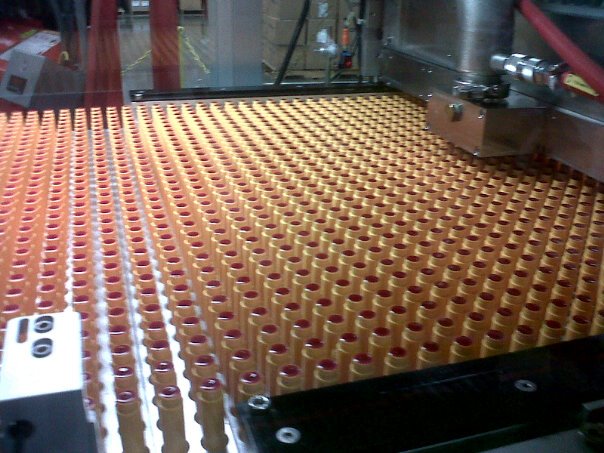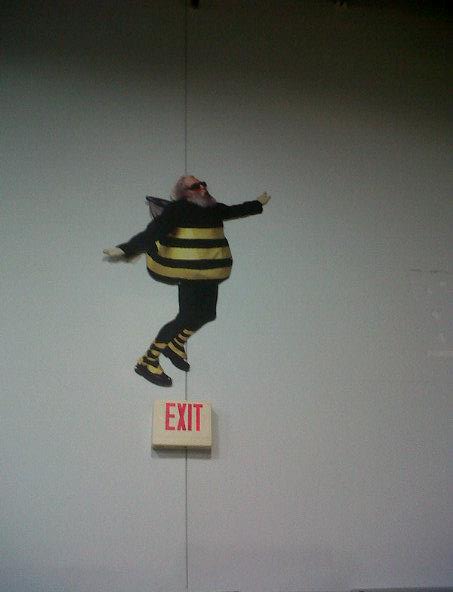Today I am going to discuss all sorts of things.
First, as per the last several posts, I am reinvestigating implementing a zero-waste-to-landfill program at Dordan. Inspired by those who presented at Green Manufacturer’s ZWTL workshop, I hope I can find a way to economically manage all of Dordan’s post-industrial waste. I am currently reviewing the figures associated with our efforts to recycle corrugate in 2011, though they aren’t too promising: It appears as though the cost of recycling—mainly transportation to the reprocessing facility—exceeded the value of the recyclate; hence, Dordan was paying to recycle its corrugate. Weird bears!
Next lets briefly discuss the tour of Burt’s Bees following the ZWTL workshop. First of all, I didn’t know that BB was purchased by Clorox in 2007; regardless, it appears to continue to uphold the original brand identity of quality, all natural products produced in America. The plant itself resembles any other manufacturing plant with portions of the production automated while others manually operated. Chap stick is BB’s bread and butter, though the exact quantity produced annually slips my mind. Check out the photo below, yum!
I guess the backstory to BBs is as follows: Burt harvested bees for honey. Not sure what to do with all the excess bees wax, Burt’s wife came up with the brilliant idea to make chapstick and other wax-based health and beauty products and TA DA, a company is born. Behind every great man…
The tour guide was a super nice guy from BB who seemed genuinely excited about its ZWTL program and overall zest of the company; that is, one of employee and community engagement and an outstanding commitment to social and environmental sustainability. BB belongs to like a million different agencies that work on the behalf of earth’s dwellers and sponsor various community-based programs, like cleaning up a waterway or what not. I just thought it was so neat that BB allowed a bunch of manufacturers into its facility to learn from its experiences working towards ZWTL. The biggest takeaway, aside from the fact that they make bats of lotion the size of bathtubs (how cool is that!), is SEPARATION AT THE SOURCE. Instead of collecting everything together and then separating by material type for recycling, why not separate it on the floor, in the caf?, in the bathroom, etc. where the “waste” is produced? BB implemented this separation at the source logic by creating a color-coded system in which employees were trained to place different materials in material-specific bins segregated by color (for example, red for plastic, yellow for paper, etc.); these bins were scattered throughout the entire facility, allowing every employee to easily dispose of the material in an efficient and non-disruptive way. It actually became easier to segregate at the source via color-coded bins then walk to the garbage can, which were increasingly nonexistent in the plant. Clever!
Do you remember how I kept alluding to feedback from the SPC meeting in regards to the organization’s request for collective reporting? Anyway I am going to pick up on this thread now—sorry for the insanely long delay!
At the last SPC meeting, the staff of the SPC summarized the impact the organization has made on sustainability in packaging: releasing tons of research reports, creating the LCA-based tool COMPASS, conducting member-led working groups, etc. As a 7-year-old organization, however, the SPC staff articulated that they felt it would be in the memberships’ interest to investigate the potential of collective reporting, thereby communicating to those outside of the organization the impact such membership has made. In other words, the SPC—through the collective reporting of its membership—wants to demonstrate the value of the organization to private and public sectors. As a non-profit, the SPC has to serve some type of public interest, as per the requirements of the tax code. As such, by encouraging its membership to quantify the environments requirements of its processes in order to establish a baseline off which progress can be gauged, the SPC hopes to communicate how it is serving a private and public good by facilitating sustainability throughout its member companies. Does that make sense?
After the SPC proposed this idea to the membership, several things happened: lots of eyebrows arched, many throats were cleared, and uncomfortable chair shifting throughout the conference room was observed. Perhaps unaware of these reactions, the SPC requested that we break into groups to discuss the feasibility of this proposition. I, sitting in the front row of course, turned around to engage with my neighbors sitting behind me. Though hesitant to discuss at first, a sort of domino effect happened in which one by one SPC members discussed how this was a really, really bad idea. The reasons sited include: not enough resources; not enough information; who will be the audience of the collective reporting? To whose purpose does collective reporting serve? Perhaps I should back up: when I say “collective reporting” I mean that each SPC member company would have to measure the environmental inputs (energy, water, materials, etc.) and outputs (GHG emissions, waste, etc.) associated with their companies’ processes and then report these figures to the SPC, who would assumingly compile the data to compare with industry averages? I don’t know as it wasn’t discussed. All I know is that data must be collected to establish a base line that progress can be charted against when discussing sustainability improvements. Without a baseline, how can anyone communicate sustainability improvements? Think of it as a company-specific LCI. So yeah, lets just say that this proposition is a MASSIVE undertaking, as speaking from Dordan’s perceptive, we don’t have the staff/resources to embark on a project in these regards without proper investment. I know that tools exist for these purposes—SimaPro being one—but they are expensive and time-consuming—the tutorial itself is over 500 pages long! So yeah, that idea kind of just…died.
That’s all for now guys! I just registered for Sustainability in Packaging! It looks really, really good. I hope to see some of you there, though I wouldn’t know as I don’t know who reads my blog!
OH, and I contributed to this Plastics Technology article. The writer Lilli explained that she was new to issues of sustainability in packaging; I think she did a great job!


